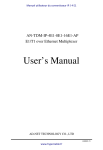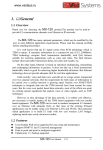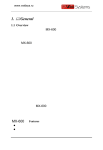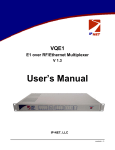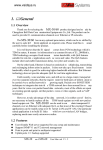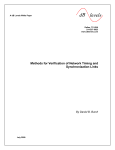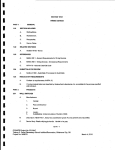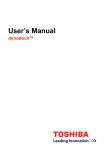Download AD-net Technology AN-TDM-IP-1E1/2E1-A User`s manual
Transcript
Manuel de l'usager du Mux IP vers 2xE1 AN-TDM-IP-1 / 2 E1 A E1/T1 over Ethernet Multiplexer User’s Manual AD-net Technology., LTD contents -1- www.hypercable.fr Manuel de l'usager du Mux IP vers 2xE1 AN-TDM-IP-1E1/2E1-A E1/T1 over Ethernet Multiplexer User’s Manual AD-net Technology., LTD 2012.03 contents -2- www.hypercable.fr Manuel de l'usager du Mux IP vers 2xE1 Disclaimer The information contained in this document is subject to change without notice and does not represent a commitment on the part of AD-net Technology., co LTD (AD-net). The information in this document is believed to be accurate and reliable; however, AD-net assumes no responsibility or liability for any errors or inaccuracies that may appear in the document. Copyright 2012 by AD-net Technology., co LTD All rights reserved. No part of this publication may be reproduced or distributed in any form or by any means, without prior written permission of AD-net. Product Model: Product Name: Manual Version: Last Update: AN-TDM-IP-1E1/2E1-A E1/T1 over Ethernet Multiplexer 1.0 Mar. 2012 AD-NET TECHNOLOGY, CO., LTD No.30-3, Lane 393, Yuantong Rd., Zhonghe City, Taipei County 235, Taiwan Phone: +886 37 269585 Fax: +886 37 265932 [email protected] contents -3- www.hypercable.fr Manuel de l'usager du Mux IP vers 2xE1 TABLE OF CONTENTS 1. GENERAL...........................................................................................1 1.1 1.2 1.3 1.4 2. OVERVIEW ............................................................................................1 FEATURES .............................................................................................1 APPLICATIONS .......................................................................................1 TIMING MODES ......................................................................................2 SYSTEM ARCHITECTURE.........................................................4 2.1 FUNCTION DESCRIPTION ........................................................................4 2.2 STRUCTURE ...........................................................................................5 2.3 FRONT PANEL ........................................................................................5 2.3.1 Diagram........................................................................................5 2.3.2 LED’s ...........................................................................................6 2.3.3 Dip Switches Definition.................................................................7 2.3.4 E1/T1 Port ....................................................................................8 2.3.5 Ethernet ports ...............................................................................9 2.3.6 Power Switch and Power Socket ..................................................10 3. INSTALLATION..........................................................................10 3.1 E1/T1 CONNECTIONS ...........................................................................10 3.2 ETHERNET/OPTIC FIBER CONNECTIONS .................................................11 4. TROUBLESHOOTING ...............................................................11 4.1 COMMON FAULT DIAGNOSIS AND RULED OUT .......................................11 4.1.1 PWR FAIL LED ON....................................................................11 4.1.2 SYS LED does not blink...............................................................12 4.1.3 Ethernet Electrical port LINK LED OFF ....................................12 4.1.4 Ethernet optical port L/A LED OFF or OLOS LED ON ..............12 4.1.5 E1/T1 Alarm LED ON.................................................................12 4.1.6 TWO ENDS DEVICES CANNOT CONNECT ..................13 4.1.7 Both Sides devices of E1/T1 have slip..........................................13 5. WEB MANAGER.........................................................................13 5.1 SYSTEM INFO ......................................................................................14 5.2 ALARM STATUS ...................................................................................14 5.2.1 E1 Channel Status.......................................................................14 5.2.2 Ethernet Port Status ....................................................................15 5.2.3 Power Status ...............................................................................15 5.2.4 Alarm Log...................................................................................15 5.2.5 BER Test .....................................................................................16 5.3 ALARM MANAGEMENT ........................................................................16 contents -4- www.hypercable.fr Manuel de l'usager du Mux IP vers 2xE1 5.3.1 Alarm Shielding Management .....................................................16 5.4 ETHERNET MANAGEMENT....................................................................16 5.4.1 Ethernet Management .................................................................17 5.4.2 Ethernet Senior Management ......................................................18 5.4.3 VLAN Management .....................................................................19 5.5 E1 MANAGEMENT ...............................................................................21 5.5.1 E1 Service Management..............................................................21 5.5.2 E1 Senior Management ...............................................................22 5.6 SNMP MANAGEMENT .........................................................................23 5.7 SYSTEM CONFIGURATION ....................................................................24 5.7.1 System time management.............................................................24 5.7.2 Change the password ..................................................................25 5.7.4 Default parameter recovery.........................................................25 5.7.4 Upgrade online ...........................................................................26 5.7.5 Reboot system .............................................................................28 6. SPECIFICATION.........................................................................28 6.1 6.2 6.3 6.4 6.5 6.6 6.7 7. CAPACITY ...........................................................................................28 E1/T1 INTERFACE FEATURES ...............................................................28 ETHERNET PORT ..................................................................................29 POWER ................................................................................................29 OPERATING CONDITION........................................................................29 DIMENSIONS ........................................................................................29 WEIGHT...............................................................................................29 APPENDIX ...................................................................................30 contents -5- www.hypercable.fr Manuel de l'usager du Mux IP vers 2xE1 www.hypercable.fr Manuel de l'usager du Mux IP vers 2xE1 AD-net Technology., CO LTD General 1. 1.1 Overview Thank you for selecting the AN-TDM-IP-1E1/2E1-A E1/T1 over Ethernet multiplexer product designed and made by AD-net Technology., LTD The product adopt the innovative TDM over IP technology, with IP circuit emulation that supports transportation of 1~2 E1 /T1 over FE port, that can be used to provide E1 communication channels over Ethernet or IP networks. In addition, AN-TDM-IP-1E1/2E1-A equipment also support the 2 local Ethernet data access, its internal buildup QoS which set the local Ethernet priority is lower than T1 / E1 data, so as to ensure the T1 / E1 signal priority transmission. The AN-TDM-IP-1E1/2E1-A have many optional parameters, which can be modified by the user to suite different application requirements. Please read this manual carefully before installing the product. 1.2 Features AN-TDM-IP-1E1-A provide 1 channel of E1/T1 over 1 Ethernet adaptive AN-TDM-IP-2E1-A provide 2 channels of E1/T1 over 1 Ethernet adaptive Provide 4 FE electrical ports (2 for uplink, 2 for user data or monitoring) and 1 Ethernet optical port optical port can be used for uplink or user data. Support IETF RFC4553 SAToP protocol, Ethernet encapsulation support IP/UDP. User-friendly Web server supported for easy setup and maintenance Support SNMP V1/V2 network management E1 clock supports 3 mode: local clock, adaptive and loopback E1 service support lossless protection Ethernet built-in layer 2 switch, support VLAN(802.1Q based and QinQ based), QoS(port based、8021.1P based and TOS based) Ethernet support IEEE 802.3x and MAC address automatic learning Ethernet packet size up to 9720byte Point to point and point to multipoint supported Software and hardware online upgrade Support SNTP network time setting Support software test E1 error 1.3 Applications AN-TDM-IP-1E1-A could be worked with E1 over Ethernet interface www.ad-net.com.tw www.hypercable.fr -1- Manuel de l'usager du Mux IP vers 2xE1 AD-net Technology. CO LTD multiplexer AN-STM-1-IP, make point-to-multipoint application ,and point of connection, Typical application is shown in Fig 1.3-1~Fig 1.3-3. point to Figure 1.3-1 Convergent Application Figure1.3-2 Typical application of wireless network Fig. 1.3-3 The typical application of cable network AN-TDM-IP-1E1/2E1-A could cooperate with wireless bridge of most manufactories in wireless network application use, At present, some the sold wireless bridge transmission bandwidth change with the Ethernet packets, some Bridges will introduce the packet delay jitter, when work with the different wireless bridge, need to adjust E1/T1 signal seaied length and jitter, in order to get the best transmission effect. Note : This equipment is used together with the wireless Bridges, usually through reticule and outdoor antenna system of wireless bridge connected, there is lightning risk at this time, must be in an upward in combination of Ethernet lightning protection protector, otherwise lightning will make seriously damage to the equipment, danger to the staff . 1.4 Timing modes To emulate a transparent E1 channel over a packet network, the AN-TDM-IP-1E1/2E1-A not only conveys data stream content correctly from the source to the destination, but also recovers the E1/T1 timing from the source at the -2- www.ad-net.com.tw www.hypercable.fr Manuel de l'usager du Mux IP vers 2xE1 AD-net Technology., CO LTD destination accurately. Packet networks do not provide such built-in timing transparency mechanism as TDM networks do. AN-TDM-IP-1E1/2E1-A uses its proprietary algorithm to reconstruct the E1 clock at the destination. The recovered clock is of very high quality, with low jitter and wander. Typical frequency offset is within ±5ppm, and jitter is below 0.1UI. It can be adopted in most applications. This timing mode of rebuilding the E1 clock at the destination is called Adaptive Timing. For applications where separate clock distribution network exists, another timing mode, Loop back Timing, may be used for maximum clock quality. In this mode, AN-TDM-IP-1E1/2E1-A rebuilds the E1/T1 output code stream using the clock extracted from E1/T1 input signals. AN-TDM-IP-1E1/2E1-A built-in memory can eliminate the wander completely. It will switch to Adaptive Timing automatically once the input signals are lost. The two timing modes of AN-TDM-IP-1E1/2E1-A are showed in Fig.1.4-1. Fig.1.4-1 E1Timing modes Correct timing mode setting is important for smooth operations. In most cases, setting both units to adaptive timing mode is sufficient. But sometimes, setting one unit to loop timing mode may work better. For example, setting the AN-TDM-IP-1E1/2E1-A unit connected with the clock master (such as local exchange) to loop back mode, and the other unit connected with the clock slave (such as PBX remote module or PCM terminal) to adaptive mode, is probably better than setting both to adaptive modes. It’s better to set the both sides AN-TDM-IP-1E1/2E1-A to loop back timing mode when the both sides equipments use synchronous master clock. In another case, set the both sides AN-TDM-IP-1E1/2E1-A to adaptive timing mode when the both sides equipments use asynchronous master clock. One typical error in telecom applications is to connect two communication devices that are both clock slaves. Neither will AN-TDM-IP-1E1/2E1-A support such operation no matter how the timing modes are set. Note: The Lock Clock usually takes several minutes to stabilize. During that period, clock drift may exceed the limit, errors and slips may occur. www.ad-net.com.tw www.hypercable.fr -3- Manuel de l'usager du Mux IP vers 2xE1 AD-net Technology. CO LTD Various timing schemes are listed in Table 1.4-1, for applications depicted in Fig.1.4-2. Fig.1.4-2 Timing mode scheme reference diagram Table 1.4-1 Timing mode schemes A side Equipment clock mode B side Equipment clock mode master master master master master slave slave master slave slave A side B side AN-TDM-IP AN-TDM-IP Timing mode Timing mode loop back loop back adaptive adaptive adaptive adaptive loop back adaptive adaptive adaptive adaptive adaptive loop back adaptive Note Equipment A & B clocks synchronous Equipment A & B clocks plesiochronous Not allowed System Architecture 2. 2.1 Function Description The core of AN-TDM-IP-1E1/2E1-A is the TDM/Packet processing unit. It truncates E1/T1 data stream, and encapsulates the data into Ethernet packet with or without IP headers. The packets are passed to the Ethernet switch unit via MII interface, and are sent out through the uplink ports. In the reverse direction, packets from the uplink ports are sent to the TDM/Packet processing unit for reassembling the original E1/T1 data stream, and outputting via E1/T1 interface. TDM/Packet processing unit need to process the reassembled data to recover the E1 clock which is the key element of the device. Very sophisticated algorithm is used to ensure that the reconstructed clock will meet the stringent requirement of TDM applications. The most important parameters are bit rate, jitter, wander, and signal delay. The user can modify various operational parameters through Network Management. -4- www.ad-net.com.tw www.hypercable.fr Manuel de l'usager du Mux IP vers 2xE1 AD-net Technology., CO LTD 2.2 Structure AN-TDM-IP-1E1/2E1-A adopt standard 1U box (W x H x D: 195 mm×35 mm×140 mm), which is composed by system board and power supply card. AN-TDM-IP-1E1/2E1-A system structure is shown in Fig 2.2-1: Fig 2.2-1 AN-TDM-IP-1E1/2E1-A system structure 2.3 Front panel 2.3.1 Diagram AN-TDM-IP-1E1/2E1-A, all service interface ,power port ,indicators and dips are in the front of panel , no indicators or dips in the rear panel , AN-TDM-IP-1E1/2E1-A front panel is shown in Fig 2.3-1~Fig 2.3-4. Fig. 2.3-1 Front panel of AN-TDM-IP-1E1/A (DC-48V) Fig. 2.3-2 Front panel of AN-TDM-IP-1E1/A (AC-220V) Fig. 2.3-3 Front panel of AN-TDM-IP-2E1/A (DC-48V) Fig. 2.3-4 Front panel of AN-TDM-IP-2E1/A (DC-48V) www.ad-net.com.tw www.hypercable.fr -5- Manuel de l'usager du Mux IP vers 2xE1 AD-net Technology. CO LTD 2.3.2 LED’s The definition is shown in Table 2.3.2-1: Table 2.3.2-1 the indicators definition of AN-TDM-IP-1E1/2E1-A Identification Green 1 PWR FAIL Red 1 L/A Green 1 OLOS Red 1 (Ethernet electrical port FDX) Green Yellow Definition Quantity SYS (Ethernet electrical port LINK) -6- Color System working state instructions Blink: Normal On: System is on configuration or work abnormally Off: System does not work or abnormally work The power failure alarm instructions On: Power Off / Failure Off: Normal 0ptical Ethernet interface state instructions On: Connected with remote Ethernet optical interface Off: Not connected with Ethernet optical interface Optical Ethernet interface receiving instructions On: No receiving Off: Receiving normally 4 Ethernet electrical interface instructions On: Link normally Blink: Data transmitting/receiving Off: Link abnormally 4 Ethernet electrical interface rate instructions: On :rate is HULL Off :rate is HALF www.ad-net.com.tw www.hypercable.fr Remark Optical Ethernet interface indicators One link indicator on the left of each Ethernet electrical interface One FDX indicator on the right of Ethernet electrical interface Manuel de l'usager du Mux IP vers 2xE1 AD-net Technology., CO LTD 2.3.3 FAR-END UP 1~2 Green 2 PKT LOS 1~2 Red 2 LOS/AIS 1~2 Red 2 1 ~ 2 channel E1 / T1 addressing the remote equipment link state instructions On: Addressing the remote MAC address Off: unaddressing the remote MAC address T1 / E1 service lost package instructions in Ethernet link On: Cannot receive the E1/T1 remote package Blink: Remote E1/T1 lost package or disorderly sequence Off: Remote E1/T1 no lost package and disorderly sequence E1 / T1 port alarm status instructions On: LOS alarm Regular slow blink: AIS alarm Irregular fast blink: receive HDB3 code ,wrong E1/T1 signal Off: no alarm Dip Switches Definition There are four Dip Switches on the front panel, the definition show in Table 2.3-2. Table 2.3-2 Dip Switches Definition of front panel Dip label DIP-1 LLB DIP-2 RLB DIP-3 MASK DIP-4 TMP_IP Definition E1/T1 port Tx to Rx loop back ON: set local E1/T1 port Tx to Rx loop back OFF: cancel local E1/T1 port Tx to Rx loop back E1/T1 port Rx to Tx loop back ON: set local E1/T1 port Rx to Tx loop back OFF: cancel local E1/T1 port Rx to Tx loop back Alarm mask set IP set ON: restore default IP address 192.192.192.192 www.ad-net.com.tw www.hypercable.fr -7- Manuel de l'usager du Mux IP vers 2xE1 AD-net Technology. CO LTD OFF: use the user’s Setting IP address There are 4 group dips on the bottom of panel, used for controlling the E1 / T1 interface impedance and 75 Ω unbalanced interface shell grounding, as the Table 2.3-3. Table 2.3-3 Dip Switches Definition of bottom panel Dip One Two Three (only SA1602 support ) Four (only SA1602support ) 2.3.4 Definition ON: the first channel of E1/T1 Interface impedance is 75 Ω OFF: the first channel of E1/T1 Interface impedance is 120Ω-E1/100Ω-T1 ON: the first channel of E1/T1 Interface shell grounding OFF: the first channel of E1/T1 Interface shell suspended ON: the second channel of E1/T1 Interface impedance is 75 Ω OFF: the second channel of E1/T1 Interface impedance is 120Ω-E1/100Ω-T1 ON: the second channel of E1/T1 interface shell grounding OFF: the second channel of E1/T1 interface shell suspended E1/T1 Port AN-TDM-IP-1E1-A equipment with 1 channel of 120 Ω-E1/100 Ω-T1 balance interface, AN-TDM-IP-2E1/A equipment with 2 channels of “120 Ω-E1/100 Ω-T1 balance interface, all adopt RJ-48 C form. RJ-48 C joints and wire sequence and signals defined as follows. 1 8 Fig 2.3-5 RJ48-C socket pin sequence Table 2.3-4 RJ-48C 120Ω-E1/100Ω-T1signal definition Pin Signal -8- 1 - 2 + E1-IN 3 GND 4 5 + E1-OUT www.ad-net.com.tw www.hypercable.fr 6 GND 7 8 Manuel de l'usager du Mux IP vers 2xE1 AD-net Technology., CO LTD Adopt 75Ω E1/T1 unbalanced interface, can be used for BH4.815.122 conversion cable which convert RJ45 to BNC connector. Fig 2.3-6 75Ω dedicated cable E1/T1 interface provide RxTx、 Tx Rx loop back operation through network management , it is convenient for operating and maintain test . 2.3.5 Ethernet ports There are four 100Base-Tx Ethernet electrical ports (two ports are uplink ports used to connect with transmission network and the other two are local data ports used to connect with local Ethernet), and one 100Base-Fx optical port used as either uplink port or local data port. Ethernet electrical port supports three modes: auto-negotiation, 10M full duplex/half-duplex and 100M full-duplex/half-duplex. Ethernet optical port supports auto-negotiation or 100M full-duplex mode. Ethernet built-in layer-2 switches function. Supporting Ethernet packet size up to 9720byte, VLAN setting based on 802.1Q or QinQ, QoS setting based on port、 8021.1P and TOS. There are four priority settings. Ethernet electrical port adopts RJ45 socket. RJ45 Ethernet socket is defined in Table 2.3-5. Ethernet optical port can use double-fiber SFP optical module and the port labeled( is for optical signal output, ( for input. Also Ethernet optical port can use single-fiber optical module which has only one optical interface. Depending on different transmission distance, Different SFP optical module could be selected. Table 2.3-5 RJ45 socket definition www.ad-net.com.tw www.hypercable.fr -9- Manuel de l'usager du Mux IP vers 2xE1 AD-net Technology. CO LTD Pin 1 2 Definition TxD+ TxD- 3 4 5 RxD+ 6 7 8 RxD- Note: 1. At auto-negotiation mode, Ethernet electrical port supports HP auto-MDIX function and it can check the transmission and receiving sequence and make configuration. So both MDI and MDI-X interfaces are supported and both cross line and direct line can be selected. 2. Network Management can be used for all the Ethernet ports except Data1 port. But to ensure VLAN setting will not impact the normal monitoring, it’s better to use the Ethernet electrical port labeled “Data2/NM” as the network management monitoring interface. 2.3.6 Power Switch and Power Socket Two power options are available, ~220V AC or -48V DC. It should be specified at the time of purchase. 3. Installation 3.1 E1/T1 connections AN-TDM-IP-1E1-A supports 1 E1-120Ω/T1-100Ω balanced interface and AN-TDM-IP-2E1-A can support 2 E1-120Ω/T1-100Ω balanced interfaces. The RJ-48C sockets are default for all the ports. Besides, it can also support 75Ω non-balanced interface by the Dip switches on the rear panel and external impedance converting cable. E1/T1 interface provide RxTx、Tx Rx through NMS, and the loopback of E1 channels can be set up independently. RxTx、Tx Rx loop back definition is shown in Fig 3.1.-1: Fig 3.1-1 E1/T1 loop back RxTx can test E1/T1 connection cable, and Tx Rx is used to test the whole circuit including AN-TDM-IP-1E1/2E1-A in the two ends and the link between them. - 10 - www.ad-net.com.tw www.hypercable.fr Manuel de l'usager du Mux IP vers 2xE1 AD-net Technology., CO LTD 3.2 Ethernet/optic fiber connections AN-TDM-IP-1E1/2E1-A provides four 100Base-Tx Ethernet electrical interfaces (two ports are uplink ports used to connect with transmission network and the other two are local data ports used to connect with local Ethernet), and one 100Base-Fx optical interface used as either uplink port or local Ethernet port such as switch. Ethernet Optical adopts SFP integrated optical modules, and the port labeled( is for optical signal output, ( for input. Also Ethernet optical port can use single-fiber optical module which has only one optical interface. The wavelength of single-fiber optical module means its luminescence wavelength, 1310nm or 1550nm. It should note that equipments with the same luminescence wavelength cannot connect with each other. So it should select the equipments with the match luminescence wavelength when using the single-fiber module. Note: 1. At auto-negotiation mode, Ethernet electrical port supports HP auto-MDIX function and it can check the transmission and receiving sequence and make configuration. So both MDI and MDI-X interfaces are supported and both cross line and direct line can be selected. 2. Network Management can be used for all the Ethernet ports except Data1 port. But to ensure VLAN setting not affecting monitoring, it’s better to use the Ethernet electrical port labeled “Data2/NM” as the network management monitoring interface. 4. Troubleshooting After power up of equipment AN-TDM-IP-1E1/2E1-A the system should start after 90seconds to work properly. The system completion startup SYS light change from long bright to flashing light. You can observe each interface light to judge each port working statue. 4.1 Common fault diagnosis and ruled out This paragraph describes common faults that may occur during installation and maintenance. Please seek support from us for other problems. 4.1.1 PWR FAIL LED ON The PWR FAIL light indicates that the corresponding power supply board is not www.ad-net.com.tw www.hypercable.fr -11- Manuel de l'usager du Mux IP vers 2xE1 AD-net Technology. CO LTD complete plugged in or not connected with, please check the following subject: the power supply to meet the requirements or not, the power plug is connected, the switch is open. 4.1.2 SYS LED does not blink After star up 90 seconds or during working statue, the SYS light flashing that is mean system have not start up completion or program problem, you can turn off the power and reboot, if still does not start up properly you need to find supplier for technical support. 4.1.3 Ethernet Electrical port LINK LED OFF Ethernet electrical port LINK light off indicates that corresponding Ethernet port does not connect properly. You can check the cable connection, cable line ordering, under mandatory mode does it using the straight-through cable (crossover cable), the electrical interface connection does match the client configuration whether, and connection with network device is working properly or not. 4.1.4 Ethernet optical port L/A LED OFF or OLOS LED ON Ethernet optical ports L/A light off indicate that the corresponding Ethernet does not establish connect properly. The OLOS light on indicates no received light. Can check the corresponding fiber is connected or not, the using single-fiber module and the equipment connected to the same emission wavelength (should using wavelength as pair optical modules), and device working properly or not. 4.1.5 E1/T1 Alarm LED ON There are two groups of LEDs, PKT LOS and LOS for E1 alarms LEDs. When E1 LOS LED is on, loss of E1 signal fault is detected by AN-TDM-IP. Possible causes include: The downstream equipment such as telephone exchange or PCM terminal is powered off. The E1 cable connection looses or broken. E1 LOS LED blinks when respective input E1 signal is AIS, i.e. the content of E1 data is all 1. Such alarm indicates fault conditions on the part of the downstream equipment. E1 LOS site is controlled by Dip Switch RA state. When RA Dip Switch ON, the red LEDs indicate remote E1 LOS state. When RA Dip Switch OFF, the red LEDs indicate local E1 LOS state. - 12 - www.ad-net.com.tw www.hypercable.fr Manuel de l'usager du Mux IP vers 2xE1 AD-net Technology., CO LTD 4.1.6 TWO ENDS DEVICES CANNOT CONNECT Both sides of devices in the same Ethernet broadcast domain, checking both side of device IP address should on dual relationship. Check MAC address is unique (include other device on the same network); Using Ping command to check network, checking bandwidth is sufficient or not. If two sides of devices are not in same Ethernet segment, checking device IP default gateway setting, IP address, IP address mask, and check conflicts of MAC address or IP address; check bandwidth is sufficient. IP address and gateway address can be set by NMS, MAC address set by manufacture. Check both ends of the device VLAN setting should be in accordance with eachother. 4.1.7 Both Sides devices of E1/T1 have slip Check both sides devices AN-TDM-IP-1E1 E1/T1 clock setting, at least one of device should be Master-Clock. Check AN-TDM-IP-1E1/2E1-A time mode setting. If both sides of the E1/T1 equipment are not in the state of the synchronization, units timing model must be adaptive timing, not loop timing. At beginning of startup, slip is normal. 5. Web Manager AN-TDM-IP-1E1/2E1-A support Web Server to monitoring devices. Login Web Server need Username and Password, the default Username and password are “admin”, as below picture showed, at System setting you can change it. www.ad-net.com.tw www.hypercable.fr -13- Manuel de l'usager du Mux IP vers 2xE1 AD-net Technology. CO LTD All Web Server include 7 parts: System Info, Alarm Status, Alarm Management, ETH Management, E1 Management, SNMP Management, and System. Following will introduce AN-TDM-IP-1E1/2E1-A. the Web Server Management of 5.1 System Info After login Web Server, will show Welcome page. In this page include Hardware version number, Software version number, Web manager version number, IP address, Subnet Mask, Gateway IP address, MAC address. IP address and Subnet address and Gateway address can be set by customer, other only for checking. As shown in Fig 5.1-1. The default setting IP address is 192.168.1.2. Fig 5.1-1 System Info 5.2 Alarm Status 5.2.1 E1 Channel Status Click left side of Alarm Status—Channel will show E1 Channel Service name, Loop status, E1 port LOS, AIS alarm and calculation of LOS, Remote Connection Status. E1 loop for testing connection, definition of LOOP please check 3.1.2. E1 Loop setting after submitting will changed, but not saved, after device startup E1 not in Loop stats. Please check Fig 5.2-1. - 14 - www.ad-net.com.tw www.hypercable.fr Manuel de l'usager du Mux IP vers 2xE1 AD-net Technology., CO LTD 图 5.2-1 E1 Alarm Status 5.2.2 Ethernet Port Status Click Left side Alarm Status – ETH Port will show 4 Ethernet electrical ports and 1 optical port LINK UP/DOWN stats, as shown in Fig5.2-2. Fig 5.5-2 ETH port Alarm Status 5.2.3 Power Status Click left side Alarm Status – Power Status will show Power Alarm Status, include 2 power ad Status information, as shown in Fig 5.2-3. Fig 5.2-3 Power Status 5.2.4 Alarm Log Click Left side Alarm Status – Alarm Log, include Alarm Type, Alarm Item, Port number, time. As shown in Fig 5.2-4. Fig 5.2-4 Alarm Log www.ad-net.com.tw www.hypercable.fr -15- Manuel de l'usager du Mux IP vers 2xE1 AD-net Technology. CO LTD 5.2.5 BER Test Click BER Test will show picture as below, include BER Enable, Testing Port, Start and Stop, Port Status (Frame synchronization or Frame Desynchronization), Bit Error Rate and Error timing, as shown in Fig 5.1-5. If you need test Error for one link, first you should click “enable” and “start”, and click “Submit”, Web Server will show result. During Testing click “Refresh” will show result of now status. Fig 5.2-5 BER Test 5.3 Alarm Management This section includes E1 channels, Ethernet port and power alarm shielding. 5.3.1 Alarm Shielding Management If set alarm mask, then this alarm will be shielded at alarm log, alarm indicator on panel and will not display no matter what situation is unless the mask is canceled. E1 channel supports not only shielding any alarm of any channel, but also batch shielding. But Ethernet port alarm and power alarm shielding can only be set one by one. As shown in Fig 5.3-1 and Fig 5.3-2. Fig.5.3-1 E1 alarm management Fig.5.3-2 Ethernet alarm management 5.4 Ethernet Management This section includes Ethernet port management, Ethernet senior management - 16 - www.ad-net.com.tw www.hypercable.fr Manuel de l'usager du Mux IP vers 2xE1 AD-net Technology., CO LTD (MAC address aging time, QoS management and port Throughput limiting) and VLAN management. 5.4.1 Ethernet Management Fig.5.4-1 Ethernet Management Table 5.4-1 Ethernet management parameters Parameters Options Port Service No. Link Speed Ethernet Management Duplex Explanation 5 Ethernet ports number Ethernet service No.: support at most 15 capital/small letters, digit and part special character input. Chinese character support 7 numbers( not support some special characters, as “ / ”、“ \ ” input). Link: indicate current Ethernet link(Up/Down) Speed: indicate current Ethernet speed(10/100Mbps) port Duplex: indicate current Ethernet work mode (HALF/FULL) 5 Ethernet ports work mode configuration: Auto-adaptive (default) Auto ,100 100M full M full, 100M half 100M 10M full Mode half, 10M half 10M full, Electrical interface work modes have Auto, 100M 10M half full, 100M half, 10M full and 10M half. Optical interface work modes have Auto and 100M full Note: The sentence with underline is default settings. www.ad-net.com.tw www.hypercable.fr -17- Manuel de l'usager du Mux IP vers 2xE1 AD-net Technology. CO LTD 5.4.2 Ethernet Senior Management Ethernet senior management supports MAC address aging time, Ethernet port QoS management and throughput limiting. MAC address aging time range is 0~99999 s (default: 300s). Fig 5.4-2 Ethernet management For Ethernet interface 1~5, we can enable QoS (based on port, 802.1p and TOS) Fig 5.4-3 Ethernet QoS configuration Port throughput limiting of Ethernet senor management includes enable Ethernet port throughput limiting and speed configuration (supporting entry speed limiting). As shown in Fig 5.4-4. Speed class of Ethernet interface is shown in Table 5.4-2. When we configure the maximum port speed, if the value is not equal to any speed class, it will select the lower speed class proximal to this value. For example, value is set to 70, after clicking Submit, the value will change to 64, means the maximum speed is 64KB. Fig 5.4-4 Ethernet senior management Table 5.4-2 Speed class of Ethernet interface Speed limiting range Lower than 2M Higher than 2M,lower than 100M - 18 - speed class interval 64KB minimum speed 64KB maximum speed 1.792MB 1MB 2MB 100MB www.ad-net.com.tw www.hypercable.fr Manuel de l'usager du Mux IP vers 2xE1 AD-net Technology., CO LTD 5.4.3 VLAN Management Two uplink Ethernet electrical interfaces support 1+1 protection. After enabling 1+1 protect, equipment configure Q in Q VLAN automatically and user only need to configure VID of uplink Ethernet electrical interface and monitoring port. As shown in Fig 5.4-5 and Fig 5.4.6. Fig 5.4-5 uplink 1+1 protect configuration Fig 5.4-6 configure Q in Q VLAN automatically AN-TDM-IP-1E1/2E1-A Ethernet supports 802.1 Q VLAN and Q in Q VLAN. 802.1Q VLAN is that adding the VLAN tag in front of Ethernet frame type. Q in Q VLAN is that nesting the VLAN (S-Tag) of operators in 802.1Q outer layer to enable the VLAN stacking. VLAN management parameters are shown in Table 5.4-3. Fig 5.4-7 VLAN management 1—VALN configuration Fig 5.4-8 VLAN management 2—E1 port configuration www.ad-net.com.tw www.hypercable.fr -19- Manuel de l'usager du Mux IP vers 2xE1 AD-net Technology. CO LTD Fig 5.4-9 VLAN management 3—Ethernet port configuration Fig 5.4-10 VLAN management 4—VLAN Table Fig 5.4-11 VLAN management 5—VLAN configuration confirmation Table 5.4-3 VLAN management parameters Parameters VLAN Mode Options Disable No VLAN tag 802.1Q Add the VLAN tag before Ethernet frame type. Q in Q Protection Control Service Protection Attribute Ethernet Port E1 Channel - 20 - Explanation Add operators VLAN (S-Tag) in 802.1Q. Realizing VLAN stack. Disable: not supply slave transmission channel. Enable: Both master and slave transmission channels transport service and no data loss during protection switching. Attribute of 1~5 Ethernet port, including uplink port and data/monitoring port. Ethernet port number 1~5. VID VLAN ID, support 4094 VLAN, ID, range (1-4094) Port E1 端口序号 1~2 www.ad-net.com.tw www.hypercable.fr Manuel de l'usager du Mux IP vers 2xE1 AD-net Technology., CO LTD Parameters VLAN Configuration Options VID Priority Eth Name Ethernet Port VLAN Configuration VLAN Table Explanation VLAN ID, support 4094 VLAN, ID, range (1-4094) Define customer priority, including 8 PRI degrees (0-7). PRI is higher when this number is bigger. Ethernet port number 1~5. VLAN ID, support 4094 VLAN, ID, range (1-4094) Define customer priority, including 8 PRI Priority degrees (0-7). PRI is higher when this number is bigger. VLAN table configurations, inquiry, add and delete. When adding VLAN group or VLAN Select members, property configuration changed, it should be tick off. VID VLAN group ID, support 1-4094 VLAN group member, it will be VLAN Mbr. member when tick off Untag tagged/untagged, ticking off means (untag) VID Note: According to the PVID value of Data2/NM port, it will automatically generate a default monitoring VLAN entry and it cannot be changed. If it needs to modify the monitoring VID value, it needs to modify the PVID of monitoring port. 5.5 E1 Management E1 management includes E1 service management and E1 senior management. Every section has many parameters setting. As shown in Table 5.5-1: 5.5.1 E1 Service Management Fig 5.5-1 E1 channel Management www.ad-net.com.tw www.hypercable.fr -21- Manuel de l'usager du Mux IP vers 2xE1 AD-net Technology. CO LTD 5.5.2 E1 Senior Management Fig 5.5-2 E1 channel senior Management Fig 5.5-3 TTL/TOS configuration of E1 channel Management Table 5.5-1 E1 Management parameters Parameters Service Name Selections Enable this E1 channel. Default: disable Enable Adaptive Timing Mode Loopback Local E1 Channel Jitter Buffer Explanations E1 service name 4~256ms Destinati on IP Source Adaptive mode:E1 timing from remote E1 stream Loop back mode:E1 timing comes from local E1 stream Local mode: E1 timing comes from local equipment crystal oscillator Jitter absorption buffer: worked with the link with bigger jitter, used to buffer the receiving packets. Coming packets buffer to eliminate jitter. Range:4~256ms Default: 16ms Remote end IP address;4 E1 line IP addresses can be set separately Default 192.168.1.3 UDP Source Port: Effective range:1024~65535 UDP Port Destination - 22 - UDP Destination range:1024~65535 www.ad-net.com.tw www.hypercable.fr Port: Effective Manuel de l'usager du Mux IP vers 2xE1 AD-net Technology., CO LTD Parameters Encapsul ation Selections IPv4_UDP 1×128 byte 2×128 byte Frame Size 4×128 byte Advanced Enable RTP Disable TTL/TOS Explanations IP Encapsulation Every Ethernet packet encapsulation length can select 1×128/2×128 字节/4×128 byte. The longer the packet is, the more E1 data encapsulated in the packet, the lower expense ratio is, the higher bandwidth efficiency is and the bigger time delay is. Vise versa. Default: 2 Real-time Transport Protocol, used to define E1 time Stamp. Default: Enable TTL: Time To Live, Default: 128 TOS: Type Of Service, Default: 184 Supplementary item: Whether E1 bandwidth is auto-adaption depends on whether enable this E1. Suggestion: If this E1 is not used, it is better to let this E1 channel disabled. 5.6 SNMP Management Fig 5.6-1 SNMP management Table 5.6-2 SNMP management parameters Parameters SNMP SNMP Read Configuration Community Information Option Explanations Read commands of device nodes (Read-only) Default: public www.ad-net.com.tw www.hypercable.fr -23- Manuel de l'usager du Mux IP vers 2xE1 AD-net Technology. CO LTD Parameters Option SNMP Write Community SNMP Trap Community SNMP Port Number SNMP Trap Address SNMP Trap Address and Port SNMP Trap Port Explanations Configure commands of device nodes Default: private Receive commands of Trap Default: public The communication ports connecting the devices with SNMP, SNMP protocol, Default: port: 16 Address used to receive Trap information: The most addresses and ports can be set is up to 5. That means the device can sent Trap information to 5 network management equipments. SNMP Trap Address needs to be configured at the first time(initial value: 0), but it can be saved and recovered. Ports used to receive Trap information: it needs to be configured at the first time (initial value: 0), but it can be saved and recovered. 5.7 System Configuration This section includes time configuration, change the password, Default parameter recovery, upgrade online and reboot system. 5.7.1 System time management System time can be modified in three ways: manually enter the time, Get Local Time or SNMP network time. As shown in Fig 5.7-1. Fig 5.7-1 system time management - 24 - www.ad-net.com.tw www.hypercable.fr Manuel de l'usager du Mux IP vers 2xE1 AD-net Technology., CO LTD SNMP management includes SNMP server option (stop/start/test), time setting interval (10~60000 minutes), SNMP server IP address and SNMP server status display (disable/enable, connect successfully/fail). Note: It needs to get the current time again once the power is off. 5.7.2 Change the password Fig 5.7-2 Change the password The change will be valid after confirm the submitting. 5.7.4 Default parameter recovery Default parameter recovery can make all the parameters recover to factory default except the IP address of equipments and the devices will reboot automatically. If not selected to remain current IP, IP address will also recover to factory default (192.168.1.2). At the same time, due to the change of IP, it will show Access failed. Then we need to restart Web Server. Fig 5.7-3 default parameters recovery AN-TDM-IP-1E1/2E1-A supports changing E1/T1 port number. For example, change AN-TDM-IP-2E1/A E1/T1 port number to 1. It is shown as follows: Step 1. Generate the configuration code by verification code. Input the MAC address of AN-TDM-IP-2E1/A and set E1 number as 1 and then click Generate. www.ad-net.com.tw www.hypercable.fr -25- Manuel de l'usager du Mux IP vers 2xE1 AD-net Technology. CO LTD Fig 5.7-4 generate configuration code Step 2. Input the configuration code and click Submit. Fig 5.7-5 change E1/T1 port number Step 3. Check the E1/T1 number in Configuration Status to confirm whether the change is successful. Fig 5.7-6 change is successful 5.7.4 Upgrade online Both AN-TDM-IP-1E1/2E1-A hardware and software program can be upgraded by ftp. Following will introduce Web Server upgrade online operation. Step 1: Use any FTP tool or input ftp://root:[email protected]/home/ftp directly in My Computer address bar to access the ftp server. And then copy the - 26 - www.ad-net.com.tw www.hypercable.fr Manuel de l'usager du Mux IP vers 2xE1 AD-net Technology., CO LTD upgrade program to the server, as figure 5.7-7. Note: Hardware program file name is H_Patch.r, and software program file name is S_patch.r. The file name cannot be changed. Fig 5.7-7 upgrade online 1—upload upgrade program Step 2: Select program type (it is available to select software and hardware at the same time) and click Upgrade to start. Fig 5.7-8 upgrade online 2—select a file/files to upgrade It may take several minutes to complete the upgrade. During the upgrade, we can refresh to check upgrade progress. Fig 5.7-9 upgrade online 3—during the upgrade When the upgrade is done, click Confirm to reboot the equipment. Login Web management again to check the version number and confirm the upgrade is successful. www.ad-net.com.tw www.hypercable.fr -27- Manuel de l'usager du Mux IP vers 2xE1 AD-net Technology. CO LTD Fig 5.7-10 upgrade online 4—operate successfully Note: If the power is off during upgrade, it may make equipment not start and need to program procedures with download line. 5.7.5 Reboot system Fig7.7-11 Reboot equipment 6. Specification 6.1 Capacity AN-TDM-IP-1E1-A: 1 E1/T1 interface, 4 100Base-Tx Ethernet electrical ports,1 100Base-Fx Ethernet optical port;AN-TDM-IP-2E1/A: 2 E1/T1 ports,4 100Base-Tx Ethernet electrical ports, 1 100Base-Fx Ethernet optical port. 6.2 E1/T1 Interface Features Comply with ITU-T G.703 recommendation End-to-end delay (minimum delay setting): ≤ 10ms Output frequency offset (adaptive timing, stabilized): ≤5 ppm Output jitter (adaptive timing): ≤ 0.1UI Interface Impedance: default:E1-120Ω/T1-100Ω; Supporting 75Ω Connector: RJ-48C Ports: AN-TDM-IP-1E1-A: 1 E1/T1 port - 28 - www.ad-net.com.tw www.hypercable.fr Manuel de l'usager du Mux IP vers 2xE1 AD-net Technology., CO LTD H0FL-AN-TDM-IP SA1602: 2 E1/T1 ports 6.3 Ethernet Port Comply with IEEE 802.3、802.1Q、802.1ad、802.1P and relative other protocol. Operating Mode:10M/100M Adaptive, Half/Full Duplex Adaptive MTU: 9720byte Connector:100M Electrical port: RJ45 100M Optical Port: LC Interface no.: 100M Electrical Port:4 100M Optical Port: 1 6.4 Power AC: 100V~260V/50Hz ~60Hz (fuse: 1A) DC: -36V ~ -72V Power Consumption: ≤4W 6.5 Operating condition Temperature: (0~45) ℃ Humidity: ≤90%RH (non-condensing) 6.6 Dimensions Width × Height × Depth (mm): 195× 35 × 140 6.7 Weight ≤ 3.5 kg www.ad-net.com.tw www.hypercable.fr -29- Manuel de l'usager du Mux IP vers 2xE1 AD-net Technology. CO LTD 7. Appendix Specialized terminologies and acronyms: Acronym TDM - 30 - Explanations Time Division Multiplex SAToP Structure-Agnostic TDM over Packet DSCP Differentiated Services Code point UDP User Datagram Protocol QoS Quality of Service TOS terms of service TTL Time To Live VLAN Virtual Local Area Network RTP Real-time Transport Protocol SNTP Simple Network Time Protocol www.ad-net.com.tw www.hypercable.fr




































